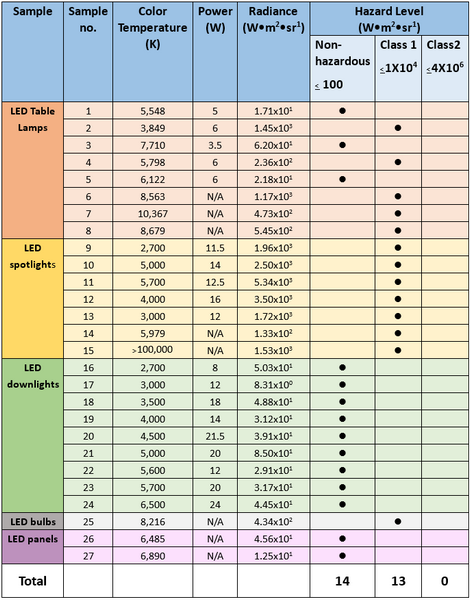A recent report by mainstream Chinese media CCTV revealing “LEDs without diffusers can cause blindness within 10 seconds” in a TV program generated much interest in China. However, studies cited in the report have been taken out of context, according to a Chinese LED test laboratory report.
The TV show interviewed LED experts, and quoted “LED lighting product’s blue-light hazard detection, blue-rich light analysis and recommendation report” by Yu Anqi, Vice President of Shanghai Institute of Quality Inspection and Technical Research (SQI). According to the report, blue light hazards and blue-rich light issues are not LED exclusive, and has long existed in previous generation lighting sources including metal halides and fluorescent lights.
The report contents:
Blue light hazard tests and analysis
LED products contain potential blue light hazards, understanding these underlying risks in LED products, the SQI or Shanghai Alpha Lighting Equipment Testing (SALT) conducted LED product compliance test findings as following:
Sample source and luminaire type:
Total LED sample: 27
Sample sources:
-
8 from small or unofficial shops
-
5 from large supermarkets
-
14 from mid-large sized manufacturers
Sample luminaire type
-
8 LED table lamps
-
7 LED spotlights
-
9 LED downlights
-
1 LED bulb
-
2 LED panels
Testing standards
-
The LED luminaire were tested and evaluated retinal damage caused by blue light.
-
The tests were categorized according to China’s GB/T 20145-2006 standard for photobiological safety of lamps and lamp systems.
-
Blue light hazard risk categorization was based on Worldwide System for Conformity Testing and Certification
-
of Electrotechnical Equipment and Components (IECEE) The Committee of Testing Laboratories (CTL) decision DSH 0744.
Blue light hazard level and corresponding standards
Blue light hazard level
According to GB/T 20145-2006 retinal damage caused by blue light can be classified into:
-
Non-hazardous (radiance ≤100 W·m-2·sr-): The luminaire does not cause any photobiological hazards even under the maximum range under the GB/T 20145-2006 standard.
-
Low level hazard (Class 1) (radiance ≤1×104 W·m-2·sr-1): Under normal lighting exposure, the luminaire does not cause any photobiological hazards.
-
Mildly hazardous (Class 2) (radiance ≤4×106W·m-2·sr-1): The luminaire does not generate glare or overheat.
-
Highly hazardous (Class 3) (radiance >4×106W·m-2·sr-1): The luminaire can cause immediate photobiological damage.
Related standards and requirements
According to IECEE CTL decision DSH 0744:
Luminaires with a brightness below 10,000cd/m2 that only emit visible light, do not require GB/T 20145-2006 hazard classification. The product can be directly used, and is automatically classified as non-hazardous. Luminaires with brightness over 10,000 cd/m2 must follow one of the protocols below.
-
If the manufacturers submit test reports proving the luminaire radiance is under GB/T 20145-2006 low hazard (Class 1) standard, then certification organizations can accept and assume the luminaire will not pose photobiological hazards under normal usage conditions.
-
If manufacturers have not supplied such a statement, they should follow GB/T 20145-2006 tests and meet the requirements stated above.
According to the eighth draft of IEC 62471-2 and IEC 60598-1, LED light sources and luminaires above Class 2 without warning labels cannot be used directly.
Test data analysis:
The product tests were analyzed for blue light hazards under two conditions including:
Data collected during normal usage of LED products. Blue light hazard analysis were conducted during LED usage. Under abnormal LED usage test conditions, the front half of the LED diffuser was removed.
Blue light hazard analysis of LED products during normal usage.
Please see table one for LEDs during normal usage test results.
 |
|
Table 1: LED sample test results under normal usage conditions. (Source: SQI/SALT) |
In table one, LED table lamp samples no. 3 and 4 diffuser could be easily removed. The two luminaires blue light hazardous levels did not exceed Class 1 under abnormal usage. Even after the diffuser was removed, the products were still safe to use.
All the diffuser panels were easy to remove in the nine LED downlights sampled. Eight luminaires blue light hazard levels were below Class 1 during abnormal usage. However, one luminaire sampled that had a Class 2 blue light hazard was not labelled according to related standards.The test data also revealed LEDs under normal usage where the diffuser is still in place’s radiance was one level lower. Therefore, diffusers should not be removed.
Blue light hazard test conclusions
-
The tests showed none of the 27 products tested with diffuser intact reached Class 2 for blue light hazard. During abnormal usage tests, where the diffuser was removed, only one sample out of 11 reached Class 2. Without protective measures the luminaire could cause harm to the human body.
-
The luminaire that reached Class 2 under abnormal condition tests used LED package components that increased luminous output. Manufacturers should pay special attention to the product’s blue light hazard level, and protective measures should be implemented. Warning labels also need to be added to luminaires.
-
Seven out of the 27 products tested had a color temperature over 6,500K, clearly exceeding lighting products white color temperature standards. Blue light also consisted a fair proportion of the color temperature. Although, the LED modules tested are low power products that did not trigger blue light hazards, the modules are no longer suitable for general lighting. Long term use can cause circadian disruption, affect sleep and chronobiology leading to lowered immune systems in the human body.
Related Report: SQI LED Blue-light Hazard Report Recommendations for Chinese LED Industry





 CN
TW
EN
CN
TW
EN






